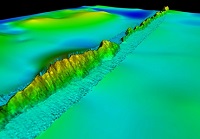News
Tuesday, June 9, 2015

A multi-national team of European, Canadian, and American ocean exploration experts lead by Thomas Furey, Marine Institute, has revealed previously uncharted features on the Atlantic seabed including mountains and ridges taller than Carrauntoohil, Ireland’s highest mountain.
The survey onboard Ireland’s national research vessel, the RV Celtic Explorer, is one of the first projects to be launched by the Atlantic Ocean Research Alliance formed following the Galway Statement on Atlantic Ocean Cooperation in May 2013. Its goals are to join resources of its three signatories to better understand the North Atlantic Ocean and to promote the sustainable management of its resources.
The team from Marine Institute and Geological Survey of Ireland (INFOMAR -national seabed mapping programme), the Fisheries and Marine Institute of Memorial University of Newfoundland, the United States’ National Oceanic and Atmospheric Administration (NOAA), and the Portuguese Institute for Sea and Atmosphere (IPMA), used the latest multi-beam echo sounder technology on the Celtic Explorer to create high resolution images of dramatic seabed features.
They uncovered 235km2 of iceberg scarred seabed, ancient glacial moraine features, and buried sediment channels on the Newfoundland and Labrador shelf. They charted a 15km long down-slope channel feature on the western Atlantic continental slope, most likely formed by meltwater run-off associated with ice cap grounding during the last glaciation, approximately 20,000 years ago. They crossed the dramatic Charlie-Gibbs Fracture Zone on the Mid-Atlantic Ridge creating a 3D visualisation of a 3.7km high underwater mountain. Continuing eastward a straight asymmetric ridge feature came to life standing proud from the flat seabed over 140km long, peaking at 1108m high, taller than Carrauntoohil.
The ambitious survey route included an area off Newfoundland and Labrador where cold water corals and sponges are known to occur and crossed the OSPAR designated Marine Protected Area in the dramatic topography of the central Atlantic. It also targeted the drop location for the first trans-Atlantic telecommunications cable laid in 1857 between Ireland and Newfoundland, and set out to groundtruth seafloor features identified through satellite altimetry research in the last two years.
“This survey marks the beginning of an exciting Atlantic research mapping collaboration between the US, Canada and Europe. It shows what can be achieved when we pool our resources, sharing knowledge, infrastructure and technology. And we hope to build on this next year, when Ireland’s R.V. Celtic Explorer will be joined by research vessels from Norway and the USA, and in subsequent years”, said Dr. Peter Heffernan, Marine Institute, Ireland.
“Seeing dramatic seabed features reveal themselves for the first time was a real highlight of the survey” said Tommy Furey, Chief Scientist, Marine Institute, Ireland. “We need to better understand the features that make up the Ocean seabed. With global population and seafood demand spiralling, we need to map our seabed to define favourable habitats for fishing, key sites for conservation, and safe navigation for shipping. Map it, manage it, and mind it.”
The survey was part funded by the Government of Newfoundland and Labrador which has invested approximately $5 million in RV Celtic Explorer expeditions since 2010 to support fisheries science activities. The vessel had just completed the annual fisheries survey in Newfoundland and Labrador, which provided the opportunity to embark on the trans-Atlantic mapping survey on the return journey to Ireland.
Results from the Atlantic Transect will be presented at the Harnessing Our Ocean Wealth conference July 10-11th, 2015 in Cork, and at the Seabed Mapping Working Group meeting preceding the event on July 9th.





